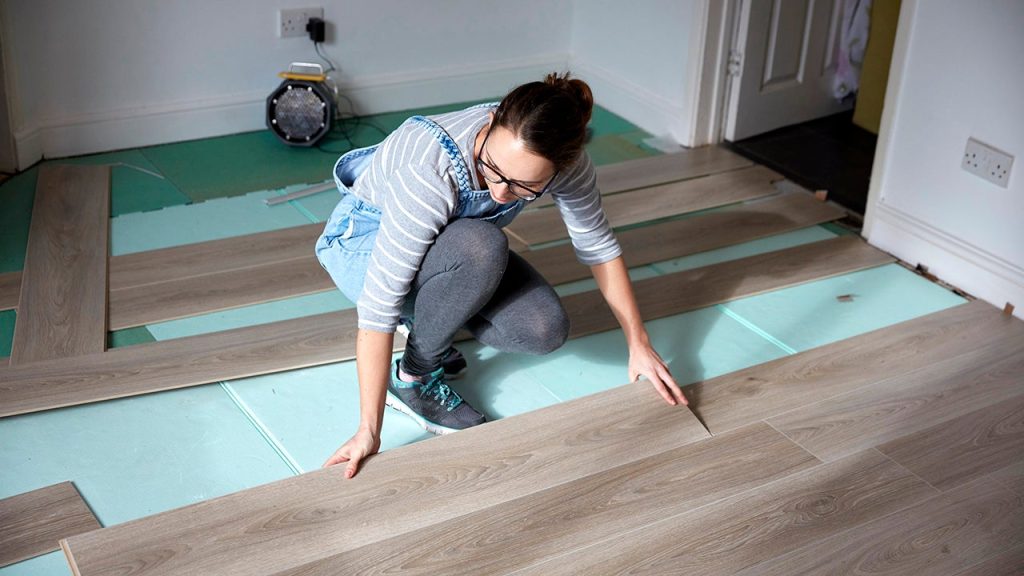- Getting a card with less long-term value: If you’re getting a store card for your home improvement purchases, it may have limited use in the long term even if it helps you reach your renovation goals. Avoid that by choosing a category card that highly rewards home improvement purchases to get extended value from your credit card.
It’s typically a good idea to use a credit card for home improvement projects since you can take advantage of zero percent promotional periods, welcome bonuses and earn rewards on what may be a significant cost. As long as you’re able to pay down the balance swiftly, the benefits may outweigh the risks for you. However if you’re going into the renovation without knowing how you’ll pay off the balance, then this likely isn’t a good idea.
There are a few factors you should consider before using a credit card for your home renovation, such as:
- How much you plan to spend
- What time frame you need to comfortably pay off the balance
- Where you’ll spend most of the money
- Your credit score
- Whether or not you need long-term value from the card
What’s next?
Get a clearer picture of what card you should choose by comparing them side by side and plot out your payoff plan with a credit card payoff calculator.
The bottom line
If you’re looking for a renovation credit card that can help you meet your home improvement goals, start with a card offering a 0 percent introductory APR. If you can earn a welcome bonus and ongoing rewards — even better. With one of today’s best 0 percent intro APR credit cards, you could preserve your cash, avoid interest and beautify your home or investment property on a reasonable budget. And if you don’t find a credit card that you want with a long enough introductory APR offer, you could try pairing a high-value rewards credit card with a top balance transfer card instead.
No matter which strategy you choose, just be sure you can pay off your balance before the end of your introductory period so you can avoid paying interest on any remaining balance.
*Information about the Upgrade Triple Cash Rewards Visa® has been collected independently by Bankrate. Card details have not been reviewed or approved by the card issuer. The Bank of America content in this post was last updated on December 9, 2024.
Read the full article here
Key takeaways
- Using a credit card’s introductory APR promotional period to finance home renovation costs can help you save money.
- If planned correctly, your card’s intro period can become an interest-free loan for supplies and services.
- Some credit cards are better than others for financing home renovations, including those with access to lucrative rewards.
Home renovations are a big business, and there’s no sign it’s slowing down soon. Whether you prefer to DIY or hire every project out, the simple fact is that home renovations cost money. In fact, Americans spent an average of $13,667 across 11.1 home projects in 2023, according to research from Angi. Having the cash on-hand to pay for these projects isn’t always possible, which is why homeowners often turn to financing options so it’s easier on the budget.
One option a homeowner might consider is using a credit card with a generous 0 percent introductory APR promotional period for purchases. By budgeting responsibly and paying off what you borrow before the promo period ends, you just might be able to use your credit card as an interest-free loan.
Tips for using a 0% APR credit card for renovations
Using a 0 percent APR credit card and paying the balance in full before the promotional period ends can give you the option of stretching out payments over time, while avoiding costly interest charges. But using these cards for renovations comes with risks that include increased credit card use and a date-driven payment obligation in your budget.
Here’s how to avoid some common pitfalls of using credit cards for large purchases like home renovations and home projects:
Maximize rewards for home improvement spending
A card with a no-interest intro period can help you extend out your renovation payments and possibly avoid interest charges, but if that card earns rewards, it can do so much more. The right 0 percent APR card can also allow you to maximize your cash back rewards or points and earn large welcome bonus offers. Here’s what to do if you want a card that provides both lucrative rewards and a strong intro APR offer:
- Look for a rewards card with a home improvement rewards category. Choose a credit card that offers generous rewards on home improvement purchases or at stores you typically shop. Some cards offer higher rewards in specific bonus categories or have a flat rewards rate on everything you buy. The Citi Custom Cash® Card and the Bank of America® Customized Cash Rewards credit card, for example, both offer boosted rewards rates for home improvements.
- Look for a card with a large welcome bonus. You should be able to reach a large spending requirement for a lucrative sign-up bonus even by simply purchasing the supplies your renovation project requires — provided you’re able to do so within the timeframe specified. You should also avoid going over budget just to qualify for the bonus — those extra rewards are not worth taking on high-interest balances. The best sign-up bonuses will be for points- and miles-earning cards as opposed to cash back cards, but those kinds of cards don’t typically come with strong 0 percent APR offers — if any. If you decide to use a card with a large welcome bonus without an intro APR offer, make sure you’re able to pay it off in full when your bill is due.
- Weigh your options between redeeming for points or cash back. You can redeem your rewards as statement credits or direct deposits, putting money back in your pocket to directly offset the costs of your project. You might also have the option to redeem rewards for gift cards to home improvement stores, which you can use on more supplies. However, if you have a points-earning card, you’ll typically lose value by redeeming points as gift cards or statement credits — although you’ll still likely net more cash back than you would with a cash back card’s earnings regardless. If you wanted to redeem your points for their maximum value, you could instead use the points you earn to offset the costs of future travel plans by using them to book your next flight or hotel.
Ryan Flanigan, a credit cards expert and writer at Bankrate, focuses on welcome bonuses and introductory APR offers the most when it comes to maximizing his rewards for home renovations.
“My house is at the age where many things need to be repaired or replaced. Whenever I have a major expense, I look for a new credit card that carries a sign-up bonus and an intro APR offer on purchases. This gives me the flexibility and time I need to pay off the repairs while giving me a nice kickback of points or cash back. I prefer this approach as opposed to just using a card with a category bonus for home improvement since I can usually get a better return this way, even when factoring in any fees a contractor might charge for using a card.”— Ryan Flanigan, Writer, Credit Cards
Be strategic when using your credit card
A great time to use a credit card is when you’ve got a large purchase that can help you meet a welcome bonus spending requirement. If you can get a 0 percent introductory APR, even better. Finally, if you can rack up rewards on one or more purchases related to your home renovations, you could stand to gain a lot when you use your credit card at the right time.
However, one card isn’t always enough to truly get the most out of a 0 percent APR offer. One card strategy to consider is pairing a credit card with high-value rewards with a balance transfer card. Using this strategy, you could pay for your renovation with a card that doesn’t offer an introductory APR but does offer a lot of rewards, then transfer the balance of that card to one that does.
Brooklyn Lowery, a credit cards expert and senior editor at Bankrate, used this strategy to pay for her kitchen renovation. Here’s how she did it:
“My husband and I are DIYers who bought a 1930s home that needed some work to make it functional for a modern family. One of the biggest projects was a complete redo — down to the studs — of the kitchen. So, rather than paying for all these big purchases out of our project savings, we opened a balance transfer credit card. We paid for everything on our rewards card, so we earned cash back on those purchases, then transferred about $12,000 to a balance transfer card. We knew we could pay it off well before the intro period expired, but doing this allowed us to keep some savings in case unexpected expenses came up during the renovation.”— Brooklyn Lowery, Senior Editor, Credit Cards
Keep in mind: If you are nearing the limit of one or more credit cards by paying for home renovations, the increase in your credit utilization ratio could adversely affect your credit score. However, your score should bounce back once your credit utilization falls back into your usual spending range.
Remember that you might also want this credit card to serve you long after your home improvement project is complete. With that in mind, consider a credit card that offers rewards aligned with your regular spending. If you’re going to be paying for gas, groceries and utility bills anyway, you might as well get something in return.
Be mindful of credit card fees
You may have situations where the fees are too costly to justify using your credit card for a renovation. More contractors accept credit card payments for labor costs, but you have to be conscious of fees they may charge for using a card. If they do charge fees, you can ask your contractor for a list of materials or accompany them to the store so you can charge materials directly to your card of choice.
And while you may be tempted to get a cash advance on your card to cover your home construction project, think twice about the high rates and fees that come with one. Most card benefits (like introductory APRs, welcome bonuses or rewards, for example) don’t apply to your cash advance. You’ll pay interest on a cash advance immediately at a higher APR — no grace period — and the higher APR and cash advance fees can make your purchase extremely expensive.
Also, it’s vital you keep up with due dates for credit card payments. Not only can you face costly late payment fees, but a late or missed payment can result in a penalty APR and losing your 0 percent promotional period, making your home improvement credit card an expensive option if you’re stuck paying the highest APR.
Have a backup plan
If you depend on low or no-interest APR offers to finance a home improvement project, make sure you can pay off the balance before the promotional APR period ends. Although these offers can easily lead to significant interest savings, it’s important to remember that they don’t last forever. If you don’t pay off the balance before the end of the promotional period, you could end up carrying a balance with a high interest rate.
If you don’t have enough cash to pay off your balance, look into other ways to pay for your home improvements, such as taking on a personal loan or home equity loan. Just be sure to read the fine print so that you understand all fees you face.
Comparing the best cards for home improvement
| Card Name | Intro APR offer and standard purchase APR | Annual Fee | Rewards rates for home improvement/shopping categories? | Welcome Offer |
|---|---|---|---|---|
| Citi Custom Cash Card |
|
$0 |
|
$200 cash back after spending $1,500 in the first 6 months. |
| Discover it® Cash Back |
|
$0 |
|
All cash back earned at the end of the first year is matched. |
| Ink Business Unlimited® Credit Card |
|
$0 |
|
$750 bonus cash back after you spend $6,000 on purchases in the first 3 months from account opening. |
| Wells Fargo Reflect® Card |
|
$0 |
No welcome bonus |
|
| U.S. Bank Cash+ Visa Signature Card |
|
$0 |
|
$200 when you spend $1,000 in the first 90 days |
| Upgrade Triple Cash Rewards Visa® |
|
$0 |
|
$200 when you also open a Rewards Checking Plus account and make 3 debit card transactions within 60 days |
The 5 best home improvement credit cards — and 1 alternative
Among the best cards for home improvements are those offering 0 percent APR promotional periods that can save you interest for 15 months or longer. Here are our five top favorites — and one alternative.
-
- Rewards rate: 5 percent cash back (on up to $500 each billing cycle, then 1 percent) on your top spending category each billing cycle; 4 percent cash back on hotels, car rentals, and attractions booked on Citi Travel℠ portal (through June 30, 2025); 1 percent cash back on all other purchases
- Welcome offer: 20,000 ThankYou points — worth $200 in cash back — after spending $1,500 in the first six months
- Annual fee: $0
- Purchase intro APR: 0 percent for 15 months
- Balance transfer intro APR: 0 percent for 15 months on balance transfers made within 4 months from date of account opening. A 5 percent balance transfer fee with a $5 minimum applies
- Regular APR: 18.49% – 28.49% (Variable)
-
The Citi Custom Cash® Card is a solid card for renovators because home improvement is one of its eligible spending categories. And you won’t have to track or activate any bonus categories to earn top rewards. To maximize this card, use it to purchase all of your home improvement purchases to max out the $500 spending limit each billing cycle and earn the most cash back.
-
Pros
Cons
- You can’t choose your own category. Bonus categories are automatically assigned based on your top eligible spending category from the previous month.
- The $500 per billing cycle cap on the 5 percent category limits your rewards on larger home improvement purchases.
- The card has a 3 percent foreign currency conversion fee.
-
- Rewards rate: 5 percent cash back on activated bonus category purchases each quarter (on up to $1,500 in purchases, then 1 percent); 1 percent cash back on all other purchases
- Welcome offer: Unlimited Cashback Match — Discover will match all the cash back you’ve earned at the end of your first year as a cardholder
- Purchase intro APR: 0 percent for 15 months
- Balance transfer intro APR: 0 percent for 15 months from account opening on eligible balance transfers. A 3 percent intro balance transfer fee applies, followed by a 5 percent fee on future balance transfers (see terms).
- Regular APR: 18.49% – 27.49% Variable APR *Rates as of December 12, 2024.
-
Although the Discover it® Cash Back may not seem like an obvious choice for a home improvement card, it’s mentioned here because its 5 percent rotating bonus categories often include stores like Amazon, Target and Walmart, all of which can be used to purchase home improvement supplies. It has also previously included home improvement stores as a category. However, Discover announces its bonus categories throughout the year, so this plan requires some flexibility and readiness to act.
It also helps that this card comes with a 0 percent intro APR offer on purchases for 15 months, followed by a 18.49% – 27.49% Variable APR *Rates as of December 12, 2024. APR , plus one of the best welcome bonuses on the market. With Discover’s Cashback Match, you’ll get double the amount of cash back that you’ve earned in a year. So, if you earned $300 in cash back, you’d get an extra $300 at the end of your first year. This can be especially lucrative if you’re making large renovation purchases with the card.
-
Pros
- Discover’s first-year Cashback Match gives this card one of the most potentially lucrative welcome offers.
- The lack of fees and no penalty APR makes this card affordable to carry long-term.
- An ample introductory purchase APR period allows you time to pay off your home project purchases.
Cons
- Bonus categories are announced throughout the year, so you’ll need to be flexible to maximize your rewards.
- If your home improvement spending doesn’t match the quarterly bonus category, the card could be less useful for you during those months.
-
- Rewards rate: Unlimited 1.5 percent cash back on all purchases; 5 percent cash back on Lyft rides through March 2025
- Welcome offer: $750 cash back after spending $6,000 within three months of account opening
- Annual fee: $0
- Purchase intro APR: 0 percent for 12 months
- Balance transfer intro APR: N/A
- Regular APR: 17.74% – 23.74% Variable
-
If you’re venturing out into the world of real estate investing and renovating a home as part of that process, having a business credit card is a great way to keep your business spending separate from your personal spending. The Chase Ink Business Unlimited® Credit Card offers a flat rate of 1.5 percent cash back with no spending cap — something that can’t be said for most of the other cards on this list. It also comes with a top-notch welcome bonus and a 0 percent intro APR on purchases for 12 months (followed by a 17.74% – 23.74% Variable).
If you don’t mind paying a $95 annual fee, its sibling card — the Ink Business Preferred® Credit Card — offers a similar scaled-up rewards system with a more lucrative welcome bonus, making it a valuable choice for real estate-related businesses ready for the next level in business credit.
-
Pros
- It offers a good introductory APR period on purchases.
- The cash back rewards are unlimited, so you’ll earn a consistent rewards rate on all purchases.
Cons
- The high spending requirement for the welcome offer may be harder to reach for businesses on a tighter budget.
- Competing cards offer a higher rate of cash back on purchases with bonus categories.
-
- Rewards rate: N/A
- Welcome offer: N/A
- Annual fee: $0
- Purchase intro APR: 0 percent for 21 months from account opening
- Balance transfer intro APR: 0 percent for 21 months on qualifying balance transfers made within 120 days from account opening
- Regular APR: 17.49%, 23.99%, or 29.24% Variable APR
-
The Wells Fargo Reflect® Card shines because it has one of the longest introductory APR periods on the market at 21 months (followed by a 17.49%, 23.99%, or 29.24% Variable APR). It doesn’t earn rewards, so it’s not the best for someone looking to maximize their points or cash back with a single card, but it’s great for someone who simply wants as much time as possible to pay off their renovation expenses.
The Wells Fargo Reflect is also a strong choice for someone who wants to pair their rewards credit card with a balance transfer card. While the Reflect comes with a 5 percent balance transfer fee (minimum $5), you could offset those costs and more depending on the rewards card you use and the amount of money you spend on your renovation.
-
Pros
- The lengthy intro APR allows plenty of time to pay off your home renovation purchases without interest.
- No rewards means you can fully focus on paying off the balance.
Cons
- Higher balance transfer fee if you’re using the card to pay off renovation purchases from another credit card.
- The lack of rewards limits this card’s long-term value.
-
- Rewards rate: N/A
- Welcome offer: $200 rewards bonus when you spend $1,000 within the first 90 days of account opening
- Annual fee: $0
- Purchase intro APR: 0 percent intro APR on purchases and balance transfers for the first 15 billing cycles
- Balance transfer intro APR: 0 percent intro APR on purchases and balance transfers for the first 15 billing cycles
- Regular APR: 18.74% – 28.99% Variable
-
The U.S. Bank Cash+® Visa Signature® Card is ideal for home improvement purchases because it allows you to choose two categories (out of 12) to earn 5 percent cash back on the first $2000 in eligible purchases each quarter. There are several categories to choose from with this card, but options you may consider for home improvement include department stores, furniture stores and even sporting goods stores. These can be great options for kitchen cabinets, new furniture, home decor, household appliances and more. So you’ll continue to get value from this card long after your renovations are complete.
-
Pros
- It has no annual fee
- You can redeem rewards for Real-Time Rewards or as a statement credit, prepaid rewards card or deposit to a U.S. bank account.
- The card comes with Visa Signature benefits.
Cons
- It charges a 3 percent foreign transaction fee for purchases or ATM transactions in a foreign currency
- It comes with very few card perks beyond those mentioned.
- The 5 percent rate only applies to the first $2,000 in combined spending each quarter (then 1 percent back).
-
- Rewards rate: Unlimited 3 percent cash back on home, auto and health purchases; 1 percent cash back on all other purchases
- Welcome offer: $200 bonus after opening a Rewards Checking account and making three debit card transactions within 60 days from account opening
- Annual fee: $0
- Purchase intro APR: N/A
- Balance transfer intro APR: N/A
- Regular APR: 14.99% -29.99% APR
-
Although it doesn’t offer a 0 percent introductory APR, the Upgrade Triple Cash Rewards Visa®* is worth mentioning for its 3 percent cash back in a wide number of home categories, such as hardware, home supplies, landscaping, HVAC systems and more. You could be approved for a credit limit as high as $25,000 and get the option to pay your balance in installments, too. This card might serve as a personal loan, particularly if you’re on the lower end of the APR range, which could be ideal for larger home improvement projects.
-
Pros
- This card features a dedicated bonus category for home purchases, which includes a wide selection of home renovation stores and purchases.
- Your card purchases are combined into a fixed rate and repayment term each month which could save you money on interest charges.
Cons
- It has no zero percent intro offer on purchases or balance transfers.
- You’ll need a higher credit score to qualify for the lower interest rate.
Frequently asked questions about using 0% APR cards for home improvements
-
There are a few drawbacks to using credit cards for home improvement purchases, such as:
- Having the potential for high interest charges: If you carry a balance past your zero percent promotional period, you’ll get stuck with interest charges at the standard variable rate which gets expensive.
- Getting a card with less long-term value: If you’re getting a store card for your home improvement purchases, it may have limited use in the long term even if it helps you reach your renovation goals. Avoid that by choosing a category card that highly rewards home improvement purchases to get extended value from your credit card.
-
It’s typically a good idea to use a credit card for home improvement projects since you can take advantage of zero percent promotional periods, welcome bonuses and earn rewards on what may be a significant cost. As long as you’re able to pay down the balance swiftly, the benefits may outweigh the risks for you. However if you’re going into the renovation without knowing how you’ll pay off the balance, then this likely isn’t a good idea.
-
There are a few factors you should consider before using a credit card for your home renovation, such as:
- How much you plan to spend
- What time frame you need to comfortably pay off the balance
- Where you’ll spend most of the money
- Your credit score
- Whether or not you need long-term value from the card
What’s next?
Get a clearer picture of what card you should choose by comparing them side by side and plot out your payoff plan with a credit card payoff calculator.
The bottom line
If you’re looking for a renovation credit card that can help you meet your home improvement goals, start with a card offering a 0 percent introductory APR. If you can earn a welcome bonus and ongoing rewards — even better. With one of today’s best 0 percent intro APR credit cards, you could preserve your cash, avoid interest and beautify your home or investment property on a reasonable budget. And if you don’t find a credit card that you want with a long enough introductory APR offer, you could try pairing a high-value rewards credit card with a top balance transfer card instead.
No matter which strategy you choose, just be sure you can pay off your balance before the end of your introductory period so you can avoid paying interest on any remaining balance.
*Information about the Upgrade Triple Cash Rewards Visa® has been collected independently by Bankrate. Card details have not been reviewed or approved by the card issuer. The Bank of America content in this post was last updated on December 9, 2024.
Read the full article here












